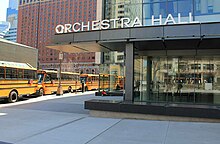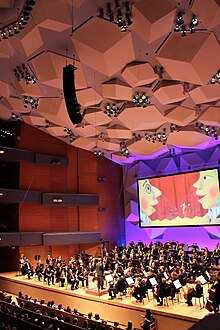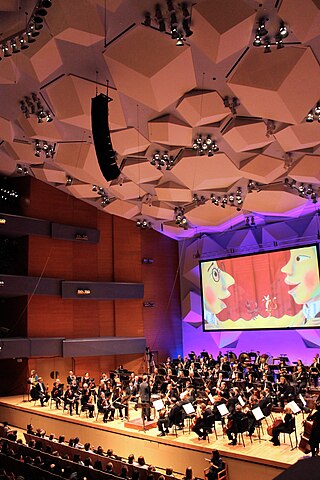
The Minnesota Orchestra is an American orchestra based in Minneapolis, Minnesota. Founded originally as the Minneapolis Symphony Orchestra in 1903, the Minnesota Orchestra plays most of its concerts at Minneapolis's Orchestra Hall.

Carnegie Hall is a concert venue in Midtown Manhattan in New York City. It is at 881 Seventh Avenue, occupying the east side of Seventh Avenue between West 56th and 57th Streets. Designed by architect William Burnet Tuthill and built by industrialist and philanthropist Andrew Carnegie, it is one of the most prestigious venues in the world for both classical music and popular music. Carnegie Hall has its own artistic programming, development, and marketing departments and presents about 250 performances each season. It is also rented out to performing groups.
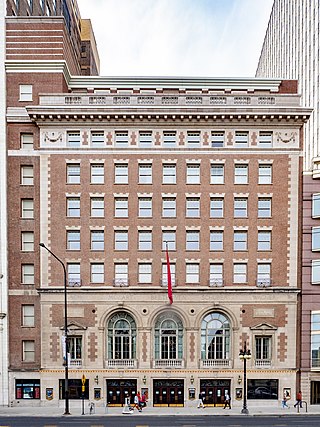
Symphony Center is a music complex located at 220 South Michigan Avenue in the Loop area of Chicago, Illinois. Home to the Chicago Symphony Orchestra; Chicago Symphony Chorus; Civic Orchestra of Chicago; and the Institute for Learning, Access, and Training; Symphony Center includes the 2,522-seat Orchestra Hall, which dates from 1904; Buntrock Hall, a rehearsal and performance space; Grainger Ballroom, an event space overlooking Michigan Avenue and the Art Institute of Chicago; a public multi-story rotunda; Forte restaurant and café; and administrative offices. In June 1993, plans to significantly renovate and expand Orchestra Hall were approved and the $110 million project resulting in Symphony Center, completed in 1997.

The Royal Festival Hall is a 2,700-seat concert, dance and talks venue within Southbank Centre in London, England. It is situated on the South Bank of the River Thames, not far from Hungerford Bridge, in the London Borough of Lambeth. It is a Grade I listed building, the first post-war building to become so protected. The London Philharmonic Orchestra, the Philharmonia Orchestra, the Orchestra of the Age of Enlightenment, the London Sinfonietta, Chineke! and Aurora are resident orchestras at Southbank Centre.

Louise M. Davies Symphony Hall is the concert hall component of the San Francisco War Memorial and Performing Arts Center in San Francisco, California. The 2,743-seat hall was completed in 1980 at a cost of US$28 million to give the San Francisco Symphony a permanent home.

David Geffen Hall is a concert hall in New York City's Lincoln Center for the Performing Arts complex on Manhattan's Upper West Side. The 2,200-seat auditorium opened in 1962, and is the home of the New York Philharmonic.

Severance Hall, also known as Severance Music Center, is a concert hall in the University Circle neighborhood of Cleveland, Ohio, home to the Cleveland Orchestra. Opened in 1931 to give the orchestra a permanent home, the building is named for patrons John L. Severance and his wife, Elisabeth Huntingdon DeWitt Severance. It is listed on the National Register of Historic Places as part of Cleveland’s Wade Park District.

Hill Auditorium is the largest performance venue on the University of Michigan campus, in Ann Arbor, Michigan. The auditorium was named in honor of Arthur Hill (1847-1909), who served as a regent of the university from 1901 to 1909. He bequeathed $200,000 to the university for the construction of a venue for lectures, musical performances, and other large productions. Opened in 1913, the auditorium was designed by Albert Kahn and Associates. It was renovated by the same firm beginning in 2002 and was re-opened in 2004.
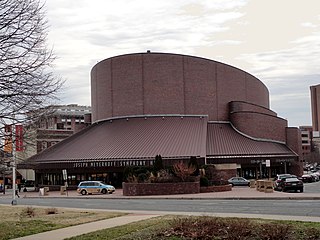
The Joseph Meyerhoff Symphony Hall, often referred to simply as the Meyerhoff, is a music venue that opened September 16, 1982, at 1212 Cathedral Street in the Mount Vernon neighborhood of Baltimore, Maryland, United States. The main auditorium has a seating capacity of 2,443 and is home to the Baltimore Symphony Orchestra. It is named for Joseph Meyerhoff, a Ukrainian-Jewish Baltimore businessman, philanthropist, and arts patron who served as president of the Baltimore Symphony from 1965 to 1983.

Alice Tully Hall is a concert hall at the Lincoln Center for the Performing Arts in the Upper West Side neighborhood of Manhattan in New York City. The hall is named for Alice Tully, a New York performer and philanthropist whose donations assisted in the construction of the hall. Tully Hall is located within the Juilliard Building, a Brutalist structure, which was designed by architect Pietro Belluschi. It was completed and subsequently opened in 1969. Since its opening, it has hosted numerous performances and events, including the New York Film Festival. Tully Hall seats 1,086 patrons. It is the home of the Chamber Music Society of Lincoln Center.
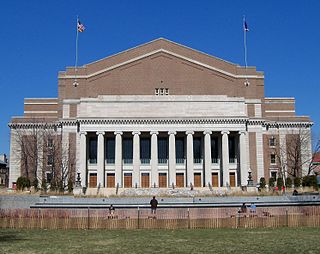
Cyrus Northrop Memorial Auditorium is a performing arts venue at the University of Minnesota in Minneapolis, Minnesota. It is named in honor of Cyrus Northrop, the university's second president. Various events are held within the building, including concerts, ballet performances, lectures, and graduations.

The Jesse H. Jones Hall for the Performing Arts is a performance venue in Houston, Texas, and the permanent home of the Houston Symphony Orchestra and Society for the Performing Arts. Jones Hall is also frequently rented as a venue for contemporary pop musicians and other performers and is estimated to draw over 400,000 audience members yearly.

The Perth Concert Hall is a concert hall located in Perth, the capital of the Australian state of Western Australia. Owned by the City of Perth, the hall is the main venue of the West Australian Symphony Orchestra, and also hosts a number of other events and performances. The building itself is located in Perth's central business district, adjacent to the Supreme Court Gardens and Government House. The building has two façades: facing north over St Georges Terrace, and facing south over the Swan River.
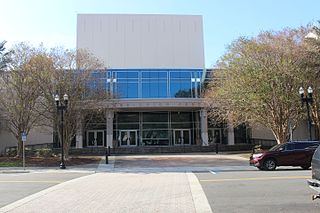
The Jacksonville Center for the Performing Arts (JCPA) is a performing arts center located in Jacksonville, Florida. Situated along the Riverbank, the venue is known as the First Coast’s "premiere riverfront entertainment facility". Originally opening in 1962, the facility was renovated beginning in 1995 until 1997; with a grand re-opening on February 8, 1997. The center consists of three venues: a theatre; concert hall and recital hall. It is home to the Jacksonville Symphony, Jacksonville Symphony Youth Orchestra, and the FSCJ Artist Series.

Royce Hall is a building on the campus of the University of California, Los Angeles (UCLA). Designed by the Los Angeles firm of Allison & Allison and completed in 1929, it is one of the four original buildings on UCLA's Westwood campus and has come to be the defining image of the university. The brick and tile building is in the Lombard Romanesque style, and once functioned as the main classroom facility of the university and symbolized its academic and cultural aspirations. Today, the twin-towered front remains the best known UCLA landmark. The 1800-seat auditorium was designed for speech acoustics and not for music; by 1982 it emerged from successive remodelings as a regionally important concert hall and main performing arts facility of the university.

Heinz Hall is a performing arts center and concert hall located at 600 Penn Avenue in the Cultural District of Pittsburgh, Pennsylvania. Home to the Pittsburgh Symphony Orchestra (PSO) and the Pittsburgh Youth Symphony Orchestra, the 2,676 seat hall presents about 200 performances each year. Originally built in 1927 as Loew's Penn Theatre, the former movie palace was renovated and reopened as Heinz Hall in 1971.
KPMB is a Canadian architecture firm founded by Bruce Kuwabara, Thomas Payne, Marianne McKenna, and Shirley Blumberg, in 1987. It is headquartered in Toronto, where the majority of their work is found. Aside from designing buildings, the firm also works in interior design. KPMB Architects was officially renamed from Kuwabara Payne McKenna Blumberg Architects to KPMB Architects on February 12, 2013.
John Sargent Pillsbury Jr. (1912–2005) was an American attorney, insurance executive, community leader, and patron of the arts in the U.S. State of Minnesota. He was a member of the Minnesota Pillsbury family, "one of Minnesota's most notable, public-spirited families" which built its fortunes in flour milling, iron ore, and forestry, and which practiced "a civic-minded capitalism that gave back to the community by supporting education, the arts and public institutions".
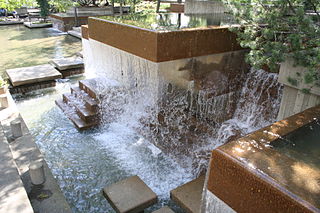
Peavey Plaza is a park plaza that serves as a public outdoor space in downtown Minneapolis, Minnesota at the south end of Nicollet Mall between South 11th and 12th Streets. The sunken plaza and its amphitheater were designed by landscape architect M. Paul Friedberg and built in 1975 alongside Orchestra Hall. The Cultural Landscape Foundation has deemed the plaza a "marvel of modernism" and it was named one of the top ten most endangered historical sites in Minnesota before its rehabilitation in 2019.
Marianne McKenna, OC, FRAIC, OAA, OAQ, AIA, RIBA is a Canadian architect and a founding partner of KPMB Architects, a Toronto-based practice established in 1987. She is an invested Officer of The Order of Canada "for her contributions as an architect, designing structures that enrich the public realm". Her projects include the renovation and expansion of The Royal Conservatory TELUS Centre for Performance and Learning and Koerner Hall. McKenna and KPMB were selected by The Brearley School, an independent all-girls school located in New York City, to lead the renovation of its building located on the Upper East Side. Her current projects also include for Banff Centre for Arts and Creativity in Banff, Alberta and an expansion and renovation of historic Massey Hall in Toronto In 2010 she was named one of Canada’s Top 100 Most Powerful Women and in 2014 she was named one of Toronto’s top 50 Powerful People by MacLean’s Magazine.


